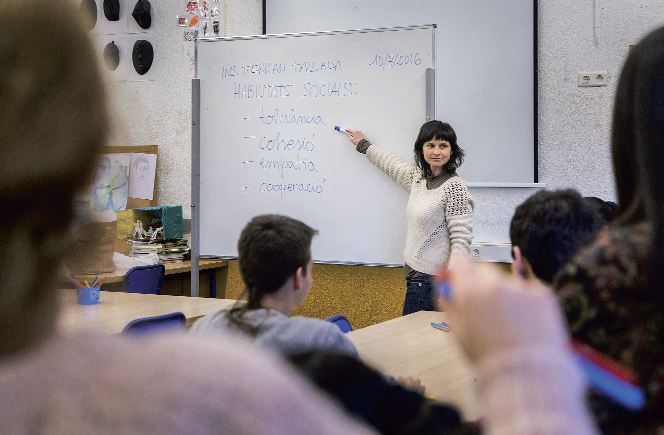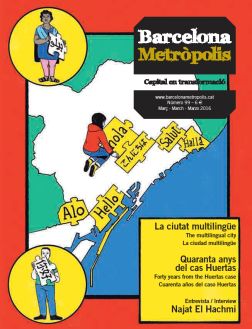While Catalan is the main working language in Catalan classrooms, Spanish enjoys more than just a token presence. Whether or not Spanish is used as a teaching tool is not based on an explicit design, but rather through the combination of the personal preferences of some teachers and students.

A class in Catalan at Institut Ferran Tallada in el Carmel. In the transition between primary and secondary school, Spanish gains ground in classrooms in the Barcelona Metropolitan area. However, it does so through bilingualism.
Photo: Pere Virgili.
School has taken on a key role in language policies around the world, and Catalonia is no exception. At this point in time, the Catalan educational language model continues to be a high-profile political and social issue. The Catalan conjunction model, which makes Catalan the working language of the educational system, has been a complete success in terms of social cohesion and, in most cases, of language learning. However, an increasingly larger number of voices and data tell us that in the classrooms – and not just on the playgrounds – of Catalonia, pupils switch between Catalan and Spanish to a greater extent than might be expected based on the theoretical model. This situation has not yet been addressed by a specific language project on how to manage this language switching in the classroom.
Language practices in the classroom are an issue that is difficult to analyse, since teaching combines different types of relationships and situations, ranging from the master classes to working in small groups, presentations to classmates, oral as opposed to written uses, etc. The same teacher will often switch between languages to address a specific pupil. The use of real material – written documentation or audiovisual resources – makes the presence of different languages in everyday teaching more common.
This situation begs the following question: which languages are used in relationships between pupils and teachers in the classroom? And what strategies do teachers use to manage languages in secondary education? To answer these questions, some of the data collected in different projects by the University of Barcelona have been used.1
A considerable number of languages currently coexist in secondary schools in the metropolitan region of Barcelona, although there are two languages that clearly play a prominent role: Catalan and Spanish. Between the legislation that seeks to make Catalan the usual teaching language and a sociolinguistic reality that makes this complicated, the data and the voices of teachers show that in different settings, and for different reasons, Spanish continues to be heard a great deal among pupils and teachers alike, albeit with significant differences in both groups.
Teachers use Catalan more in the classroom than pupils, whereas the latter use both languages more than their teachers. Generally speaking, teachers tend to use Catalan in the classroom by default; nevertheless, they often, unconsciously and routinely, tend to address certain pupils in Spanish, as exemplified by a Catalan language teacher from Mataró: “Teachers say that they teach classes in Catalan, but what does teaching a class in Catalan actually mean? It means starting and finishing in Catalan, and not that a pupil addresses you in Spanish and you respond in Spanish.”
In some cases, Spanish is used as a teaching resource in the classroom, and a minority of teachers do classes in Spanish only. This is confirmed by the management team of a school in Sant Joan Despí: “The working language is Catalan. Although Spanish is sometimes heard in classrooms. […] There are still some people who do half the class in Catalan and half in Spanish, or some who teach the whole class in Spanish. Although the majority teach in Catalan, I’m talking about a certain minority”.
From the longitudinal standpoint, the use of Catalan by teaching staff in the classroom follows a somewhat undulating dynamic: it plummets between the final year of primary education (79%) and first year of compulsory secondary education (ESO) (68%), but begins to rise again between the first and fourth (final) years of ESO (70%). The significant change in the language used by teachers is the transition into secondary education.
The use of Catalan among pupils falls between the final year of primary education (73%) and the final year of ESO (58%). The educational use of Spanish gains ground in the transition into secondary education, not so much in an isolated way as on a bilingual basis, to the extent that almost one-third of the pupils use both languages in the classroom. Around 7% of pupils in the municipalities of the metropolitan region of Barcelona say they only speak Spanish to all teachers. This is because, on the one hand, some pupils still have a poor command of Catalan even after completing primary education, and, on the other, some pupils have a negative attitude towards Catalan and even question its role in secondary education.
Faced with this minority, most teachers avoid open conflict and politicisation, and look for arguments in favour of the use and the usefulness of Catalan language. We have identified different strategies.
The first is the moral and emotional strategy: teachers appeal to pupils’ sense of respect, affection and empathy towards languages. The premise is that world and local linguistic diversity must be respected and that languages are related to our emotions.
The second is a social strategy, i.e. the aim is to link language to social aspects outside the classroom, based on the idea that we live in a rich sociolinguistic environment where different languages coexist, and explaining that these languages are a source of knowledge.
In third place we have instrumental strategies. Language is presented solely as a communication tool, very often with a view to dodging the issue and so as not to politicise it. Other teachers resort to their authority; in other words, they foster the use of Catalan in the classroom through punishments and incentives related to marks.
Finally, a substantial number of teachers state that they have no strategy for tackling sociolinguistic challenges in the classroom, although they acknowledge that such challenges exist. As a final-year ESO teacher from Mataró puts it: “We try to get pupils to at least speak Catalan in all subjects, do their exams in Catalan, and mark them down for mistakes . However, getting all the pupils to speak Catalan is by no means an easy feat.”
In conclusion, it is clear that the Catalan conjunction model conceals a broad variety of language practices. The data from different projects show that while Catalan is the main working language, the presence of Spanish is far from trivial, particularly in secondary education. There is a sizeable percentage of primary and secondary education pupils who say that they also interact with their teachers in Spanish in the classroom, and the number of pupils who state that at least some of their teachers address them in this same language is also highly significant.
It would therefore be necessary to find out more about how these bilingual uses are organised, as well as about what their outcomes are in terms of learning the languages in question. The data available lead to think that whether or not Spanish is used as a teaching tool is not established by an explicit design, but instead through the combination of the personal preferences of some teachers and students. For this reason, many teachers find themselves in complex sociolinguistic situations. Some of them cope admirably, undoubtedly because they have experience or even sociolinguistic training. But it is equally evident that other teachers use strategies that do not always work for them, or they feel defenceless. In that regard, it would be useful to provide for some type of initial or ongoing training in sociolinguistics in secondary education.
Note
- The specific projects that prompted the study are: Resocialització i llengües (RESOL): els efectes lingüístics del pas de la educació primària a secundària en contextos plurilingües (2006-2009) [Resocialisation and languages: the linguistic effects of the transition from primary to secondary education in multilingual settings], and Resocialització lingüística en educació secundària (RESOLSEC) (2010-2012) [Linguistic Resocialisation in secondary education], both by the University of Barcelona’s University Centre for Sociolinguistics and Communication, and Diversitat sociocultural i adquisició de la confiança lingüística en català i castellà (2012-2015) [Sociocultural diversity and acquisition of language confidence in Catalan and Spanish], as part of RecerCaixa2012. Further information at CUSC.




Article interessant. Seria interessant saber (en una altra ocasió, amb més espai) de quina mena d’usos parlem quan diem “L’ús del català entre l’alumnat”, “l’ús escolar del castellà “, “prop d’un terç de l’alumnat utilitza les dues llengües dins les aules”, si es tracta de l’ús dins de l’aula amb altres companys, amb els professors…
L’última frase (“En aquest sentit, seria útil preveure algun tipus de formació inicial o permanent al voltant de la sociolingüística en l’àmbit de la secundària”) em sembla molt important: a veure si posem fil a l’agulla, des del departament, des de les universitats… I el mateix caldria per millorar la qualitat de la llengua dels mestres i professors, que sí que es podria millorar fins a un cert punt.